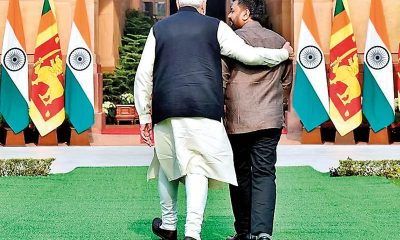Opinion
Protesters and those who plan to suppress them in Sri Lanka

By Ananda P. Dasanayake
The government of Sri Lanka published its proposed Anti-Terrorism Act (ATA) on 17 March 2023. If adopted, it would replace the old Prevention of Terrorism Act (PTA) of 1971. The PTA was invoked mainly to deal with the Liberation Tamil Tigers of Eelam (LTTE) terrorism in northern Sri Lanka. After the war was over, the government came under pressure from sections of the international community, including the United Nations Human Rights Council (UNHRC), to repeal the PTA and replace it with a new law that conforms to international standards in countering terrorism.
The word terrorism came into the Sri Lankan political vocabulary in 1971 when I was a teenager. A group of educated, yet rebellious youth led an insurrection in 1971 against the corrupt rulers and the declining living conditions of the poor. Then the government used emergency laws to curb the uprising. This group is also alleged to have led the 1988-89 violent acts. The PTA Bill of 1971 was used to curb that.
The new ATA bill purports to do away with the provisions of the PTA that were considered in violation of international human rights law. Instead, the new Bill places the power to make detention orders in the hands of a Deputy Inspector General of Police, a power which under the PTA was held by the Minister of Defence. Critics including the Tamil National Alliance (TNA) have already raised objections to the provisions of ATA. The danger of the new bill is that any ordinary citizen, living in Sri Lanka or abroad, who criticises any element of the government under the freedom of expression right can now be considered a terrorist by the new and very loose definition of terrorism in the ATA. Under this definition, any citizen who is politically conscious or active can be labeled as a terrorist and arrested by the rulers. The proposed Anti-Terrorism Act would empower the authorities to systematically violate fundamental human rights, Human Rights Watch said. “The proposed counterterrorism law would permit the Sri Lankan government to continue to use draconian measures to silence peaceful critics and target minorities,” said Meenakshi Ganguly, South Asia director at Human Rights Watch. “The government’s crackdown on dissent and misuse of existing counterterrorism laws to arbitrarily detain protesters highlights the obvious risk of abuse.”
In an interview given to the BBC, Justice Minister Wijeyadasa Rajapakse, who drafted the bill, claimed that the new bill was developed after studying counter-terrorism laws of the countries such as the United States, India, the United Kingdom, and Germany. The International Conference of Jurists (ICJ), however, says that the newly proposed anti-terrorism legislation, if adopted as currently formulated, will give rise to a panoply of human rights violations, as much as the PTA was open to misuse. The Minister’s defence of the bill seems to be based on the provision that the magistrates can intervene if there are any wrong accusations. This claim is ridiculous given that Sri Lanka has no independent judiciary or transparent law and order as most judges and law enforcement officials are in the pockets of powerful politicians.
The ATT has some new features as well. It contains what the rulers learned from the recent people’s uprising (known as Aragalaya in Sri Lanka) that led to the ouster of the then President Gotabaya Rajapakse. Aragalaya took place when the Sri Lankan civilians took to the streets in droves in March 2022, semi-organised, to protest the corrupt rulers and their devastating policies. The government brutally attacked them together with the journalists and banned all social media, and unconstitutionally imposed a 72-hour curfew and emergency law. The US Ambassador to Sri Lanka, Julie Chung tweeted that Sri Lankans have a right to protest peacefully. Under the ATA, the president has the power to label the internet and new technology-based campaigns, social media, and democratic activism that were crucial during the Aragalaya as terrorist activities. The new act refers to the presidential powers in 42 places compared to just 11 places in the PTA.
Despite all these concerns, the public, both urban and rural, have no real understanding of what the ATA entails. They are of the opinion that the ATA applies only to the ‘terrorists’ in a traditional sense such as those who bomb places, etc., and not to them. But under the ATA, anyone can now be considered a terrorist except the rulers of the country. If you call a corrupt politician corrupt, you will be considered a terrorist. Some ministers have openly threatened the protestors by saying that they have enough water in the Beira Lake (a place that played a significant role during the Aragalaya), and enough tear gas canisters bought using the borrowed money. These threats need to be highlighted and publicly debated. The current discussion on the subject is limited to a few news conferences by the opponents, a few news articles based on expert reviews, and some international dissent.
While President Biden and Vice President Harris trot the world emphasising the importance of global democracy, the corrupt Sri Lankan rulers who are emboldened by the recent IMF loan they secured are trying to kill democracy in Sri Lanka for sure. The US ambassador to Sri Lanka should express her concerns about the danger of the proposed act just like the European Commission and Human Rights Watch have already done. The USA could easily influence the Sri Lankan government as they depend on the IMF.
Prof. Ananda P. Dasanayake is a Public Voices Fellow of The Op-Ed Project in partnership with New York University.
Opinion
Boxing day tsunami:Unforgettable experience

The first and only tsunami that Sri Lanka experienced was on Boxing Day(26th) of December 2004. My wife and I, as usual, went down to Modara in Moratuwa to purchase our seafood requirements of seafood from our familiar fishmonger, Siltin, from whom we had been buying fish for a long time. Sometimes we used to take a couple of friends of ours. But on this day, it was only both of us that went on this trip.
We made our purchases and were returning home and when we came up to the Dehiwala bridge, many people were looking down at the canal from both sides of the bridge. This was strange, as normally if there was something unusual, it would be on one side.
Anyway, we came home unaware of anything that had happened. A school friend of mine (sadly he is no longer with us) telephoned me and asked whether I was aware of what had happened. When I answered him in the negative, he told me to switch on the TV and watch. Then when I did so and saw what was happening, I was shocked. But still I did not know that we had just managed to escape being swept away by the tsunami.
Later, when I telephoned Siltin and asked him, he said that both of us had a narrow escape. Soon after we had left in our car, the tsunami had invaded the shore with a terrifying wave and taken away everything of the fishmongers, including their stalls, the fish, weighing scales and money. The fishmongers had managed to run to safety.
This had been about five minutes after we had left. So, it was a narrow shave to have escaped the wrath of the demining tsunami( the name many Sri Lankans came to know after it hit our island very badly}
HM NISSANKA WARAKAULLE
Opinion
Shocking jumbo deaths

Sri Lanka has recorded a staggering 375 elephant deaths in the past eleven and a half months due to a multitude of causes, according to the Department of Wildlife Conservation. U. L Thaufeeq, Deputy Director – Elephant Conservation said the deaths include 74 from gunshots, 53 from electrocution, 49 from hakka patas (explosive devices hidden in food), seven from poisoning, 10 from train accidents, three from a road accident, and six by drowning. It makes such diabolical reading!
“The causes of other deaths are due to natural causes or causes that could not be identified. Most of the elephants that died were young,” the official said.
Meanwhile, the human-elephant conflict has also taken a toll on people, with 149 human deaths reported this year.
Accordingly, human-elephant conflict has resulted in 524 deaths of both elephants and humans in 2024.
In 2023, a total of 488 elephants and 184 people have died consequent to the conflict, according to Wildlife Department statistics.
The human-elephant conflict in Sri Lanka has escalated to unprecedented levels with reasons like habitat destruction, encroachment, and the lack of sustainable coexistence measures contributing to the issue.
This is an indictment of the Wildlife Department for just giving the sad yearly statistics of shocking losses of our National treasures !
Given the fact that Sri Lanka boasts of 29.9% of the country declared as protected forests, Sri Lanka is a haven for nature lovers. Boasting 26 national parks, 10 nature reserves including 3 strict nature reserves, and 61 sanctuaries, the national parks in Sri Lanka offer an incredible variety of wildlife experiences.
Taken in that context, the million dollar question is why on earth the Wildlife Department is not being proactive to capture these magnificent animals and transport them into protected sanctuaries, thus effectively minimising dangers to villagers ?
Being a Buddhist country primarily, to turn a blind eye to these avoidable tragic deaths to mankind and wild elephants, we should be ashamed !
As a practising Buddhist myself, I think our clergy could play a major part in calling upon the Wildlife Department to get their act together sooner rather than later to protect human elephant conflicts !
Sri Lanka being a favourite destination amongst foreign tourists, they are bound to take a dim view of what is happening on the ground!
If the top brass in the responsible department are not doing their job properly, may be there is a case for the new President to intervene before it gets worse!
All animal lovers hope and pray the New Year will usher in a well coordinated plan of action put in place to ensure the well being of wildlife and villagers !
Sunil Dharmabandhu
Wales, UK
Opinion
Laws and regulations pertaining to civil aviation in SL, CAASL

This has reference to the article from the Aircraft Owners and Operators Sri Lanka, titled ‘Closer look at regulatory oversight and its impact on Tourism’, published on Tuesday, 24th December 2024.To explain further, in the beginning there was the Air Navigation Act No 15 of 1950 which was followed by the Air Navigation Regulations (ANR) of 1955. This was long before the national airline had acquired pressurised aircraft, intercontinental jets, sophisticated navigation equipment, satellite communication and automatic landing systems, and ‘glass’ flight-deck instrumentation.
Today, civil aviation in Sri Lanka is governed by Civil Aviation Act Number 14 of 2010. Yet the Air Navigation Regulations (ANR) promulgated back in 1955 remain in force.
These outdated regulations still stipulate rules forbidding the carriage of passengers on the airplane’s wings or undercarriage (landing gear). In short, they are neither practical nor user-friendly. In contrast, the Air Navigation Regulations of other countries have progressed and are easy to read, understand, and implement.
To overcome the problem of outdated regulations, as an interim measure in 1969 the then Minister of Communications and Transport, Mr E.L.B. Hurulle issued a Government Gazette notification declaring that the Standard and Recommended Procedures (SARPs) in Annexes to the ICAO Convention signed by Ceylon in 1944 shall be made law.
Even so, nothing much was done to move with the times until updating of the Civil Aviation Act 14 of 2010, while the Air Navigation Regulations remained unchanged since 1955. However, these regulations were modified from time to time by the promulgation of Implementing Standards (IS) and General Directives (GDs) which were blindly ‘cut and pasted’ by the Civil Aviation Authority of Sri Lanka (CAASL), from the ICAO (International Civil Aviation Organisation) Annexe ‘SARPS’ without much thought given. To date there are literally 99 IS’s starting from 2010.
The currently effective air navigation regulations are not in one document like the rest of the world, but all over the place and difficult for the flying public to follow as they are not regularly updated. This sad situation seems to have been noticed by the current regime.
The National Tourism Policy of the ruling NPP states, “Domestic air operations are currently limited due to high cost and regulatory restrictions. The current regulatory and operational environment will be reviewed to ensure domestic air connectivity to major tourist destinations. The potential of operating a domestic air schedule with multiple operators is proposed. Additionally, domestic airports and water aerodromes in potential key areas will be further developed, for high-end tourism growth.”
“The tourism policy recognises Sri Lanka’s potential to develop Sri Lanka’s aviation-based specialised tourism products, including fun flying, hot air ballooning, paragliding, parachuting and skydiving, and scenic seaplane operations. To facilitate the growth of these niche markets, existing regulations will be reviewed with the aim of attracting capable investors to develop and operate these offerings.”
It remains to be seen whether the NPP government lives up to those promises.
Note:
That OPA report talks of two funds: ‘Connectivity’ and ‘Viability’ for a limited period like three or five years to help jump-start the domestic aviation industry.
The ‘Connectivity Fund’ will cap the seat price for local passengers to a more affordable value to destinations while the ‘Viability Fund’ will assume that all seats are occupied and compensate the operator for any unutilised seat. The intention is to popularise domestic aviation as a safe, quick and convenient mode of transport.
Capt. Gihan A Fernando
RCyAF/ SLAF, Air Ceylon, Air Lanka, Singapore Airlines and Sri Lankan Airlines.
Now A Fun Flier
-

 Sports5 days ago
Sports5 days agoPathirana set to sling his way into Kiwi hearts
-

 News3 days ago
News3 days agoOffice of CDS likely to be scrapped; top defence changes on the cards
-

 News6 days ago
News6 days agoSL issues USD 10.4 bn macro-linked bonds
-

 Editorial6 days ago
Editorial6 days agoRanil’s advice
-

 Editorial5 days ago
Editorial5 days agoThe games they play
-

 Features3 days ago
Features3 days agoAn Absurd play in Parliament: Qualifications versus education
-

 Features5 days ago
Features5 days agoThe Government’s Term Tests & Results: The Good, the Bad and the Ugly
-

 Opinion4 days ago
Opinion4 days agoWhat AKD and NPP should bear in mind























